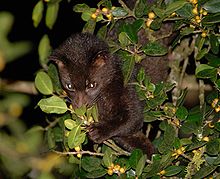Jerdon's palm civet
| Brown palm civet | |
|---|---|
 |
|
| Scientific classification | |
| Kingdom: | Animalia |
| Phylum: | Chordata |
| Class: | Mammalia |
| Order: | Carnivora |
| Family: | Viverridae |
| Genus: | Paradoxurus |
| Species: | P. jerdoni |
| Binomial name | |
|
Paradoxurus jerdoni Blanford, 1885 |
|
 |
|
| Brown palm civet range | |
The brown palm civet (Paradoxurus jerdoni) also called the Jerdon's palm civet is a palm civet endemic to the Western Ghats of India.
The brown palm civet has a uniformly brown pelage, darker around the head, neck, shoulder, legs, and tail. Sometimes the pelage may be slightly grizzled. Two subspecies have been described on the basis of the colour of the pelage although the colour is extremely variable, ranging from pale buff or light brown to dark brown. The dark tail sometimes has a white or pale-yellow tip. It has no distinct markings on the body or the face as in the common palm civet. A distinctive feature is the reversed direction of hair growth on the nape, similar to that in the golden palm civet (P. zeylonensis) of Sri Lanka. It is about as large as the common palm civet, but with a long and sleek tail. The body weight of the males ranges from 3.6 kg to 4.3 kg, head and body length 430 mm to 620 mm, and tail length from 380 to 530 mm. The species was described in 1885 on the basis of a skull and pelt obtained in Kodaikanal by Mr F. Levinge and forwarded by Rev. S. B. Fairbank to Blanford. Blanford noted the long foramen on the anterior palate. He also found the pelt matching another specimen collected by Francis Day. Blanford named the species in honour of T. C. Jerdon. Subspecies caniscus was described by Reginald Innes Pocock on the basis of a specimen collected at Virajpet in southern Coorg.
There are two subspecies, the nominate P. j. jerdoni and P. j. caniscus. The Sulawesi palm civet is sometimes referred to by the same English name due to its brown colour.
The brown palm civet's distribution extends from the southern tip of Western Ghats in Kalakkad Mundanthurai Tiger Reserve to Castle Rock in Goa to the north. They are nocturnal, and not as rare as previously thought and sight records of the species in Kodaikanal and Ootacamund where they were earlier considered to be locally extinct are an indication of their ability to go unnoticed.
...
Wikipedia

